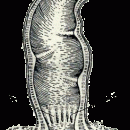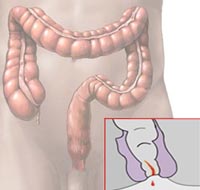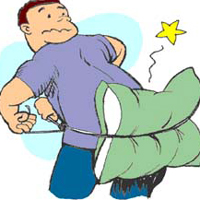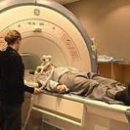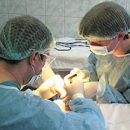Why anal itch occurs? Read in this article.
Content
Anal itch
Anal itching - pathological condition characterized by a stubborn itch in the area of the rear pass. This disease is found quite often, and the coloprocontologists are known how serious it is, and how difficult it is to achieve a persistent positive result of treatment.
Causes of occurrence
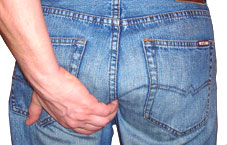 Idiopathic itch. Most often without explicit specific reasons. Due to the reduction in the ability to hold fluid in anus, a small amount of mucus from the rectum falls on the skin of the perianal region and causes it irritation.
Idiopathic itch. Most often without explicit specific reasons. Due to the reduction in the ability to hold fluid in anus, a small amount of mucus from the rectum falls on the skin of the perianal region and causes it irritation.
Anorectovaginal diseases : Hemorrhoids, fistulas, cracks, Pointed Condylomes, purulent hydrabenitis, tumors, sphincter dysfunction, vaginal secret.
Dermatological diseases: psoriasis, seborrheic dermatitis, atopic eczema, flat deprived, etc.
Contact dermatitis from local use of ointments, deodorants, powders, soap, supositories and t.NS.
Infection: fungi (sandida), bacteria (mass).
Parasites: worms, trichomoniasis, scabies, lobcovaya.
Oral antibiotics: Tetracyclines, erythromycin, etc.
Systemic diseases: Sugar diabetes, liver disease.
Personal hygiene: insufficient or excessive.
Heat and humidity: Narrow clothes, warm climate, obesity, intensive physical activity.
Food: drinks (coffee, tea, cola, milk, beer, wine), food (seasonings, sharp peppers, tomatoes, citrus, chocolate).
Psychogenic reasons: Anxiosity, etc.
Manifestation
Often itching in the area of the rear pass is the main and only complaint of the patient.
By clinical flow, it is advisable to distinguish with a sharp and chronic true anal itch. For the first shape (stage), a sudden start, constant course, significant intensity and local changes of the skin type of wet eczema with maceration, traces of combs, hypertrophy of perianal folds. In chronic tube, on the contrary, the beginning of a slow, the skin is more often dry, thinned (it is compared with parchment paper), sometimes depigmented, there are no traces of combs at all or they have the kind of thin linear abrasions, the folds of the skin radar, are defined little («Spokes of wheels»).
Types
Anal itching should be clearly divided into «primary» (Synonyms: true, supine, cryptogenic, idiopathic, neurogenic, essential) and «secondary», Often accompanying diseases such as hemorrhoids, anal crack, wicked invasions, proctosigmiditis of various etiologies, the insufficiency of the sphincter of the rear pass, constipation (diarrhea), inflammation of the genitals, the impact of harmful endo- and exogenous substances and factors, fungal lesions of the skin in the sacrum -Capper area. In addition, anal itching can be one of the early signs of hidden diabetes.
If the reasons for the occurrence of the secondary anal itch listed above are more or less known, the etiology of the primary, true, itching this region is not fully studied.
Diagnostics
Diagnose the disease seems to be simple: itching in the area of the rear pass is the main and only complaint of such patients. However, the determination of the type of itch (true or secondary), its stage (acute or chronic), forms (dry or wet), as well as the clarification of the reasons for the secondary itch is not so simple.
First of all, you should install:
- Is itching with defecation. This feature may indicate the insufficient function of the sphincter of the rear pass, which is often observed in chronic hemorrhoids, the deposit of the rectum, various traumatic damage to the sphincter (postpartum, postoperative, etc.), nervous lesions (especially in children), sex perversions. Determine the degree of insufficiency can be possible only with the help of sphincterometry;
- Li itching after taking alcoholic beverages, acute or salted food: the presence of this feature indicates the presence of proctosigmoiditis;
- Does not have a patient in everyday life or on the production of harmful effects — Chemical production, irradiation, work in dusting premises, in high temperature conditions and t. NS.;
- there is no close contact with pets (Glice invasion);
- The presence of a patient or his relatives of diabetes, fungal lesions, constipation, diarrhea.
From laboratory studies with anal itching, blood tests for the sugar content and three-time analysis of the feces on the eggs of worms. When pathological changes are detected using conventional (tough) rectoromanoscopy, irrigoscopy should be performed. Men need to eliminate urethritis and prostatitis, in women — Vaginal itch. In the presence of an unstable chair, a bacteriological analysis of the feces on the microflora should be made: with pronounced dysbacteriosis, the therapy of the anal itch should include special preparations.
Treatment
Treatment of anal ferry — The case is complex, requiring patience and perseverance of the doctor and the most patient. 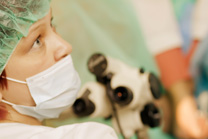 With secondary itching the action of the doctor is unequivocal — Therapy of the main disease.
With secondary itching the action of the doctor is unequivocal — Therapy of the main disease.
It is important to diagnose even the initial stages of hemorrhoids, papillitis, cryptite, not to mention an anal crack, the deposit of the rectum or the insufficiency of the sphincter of the rear pass of any etiology. In these cases, as a rule, itch is the symptom of the main disease.
If the proctochmyitis is revealed at the reorganoscopy, then it is necessary to carry out a full course of appropriate treatment.
If intestinal dysbacteriosis is revealed without proctoigmiditis, then the treatment of anal itching is combined with the appointment of bacterial preparations.
However, the most persistently proceeds are the forms of the anal itch, under which the most thorough question of the patient, clinical and laboratory studies do not detect any pathology. And in these cases, treatment should be treated with therapy of hidden proctosigmoiditis: diet, microclides with collargol, skin ointments. To remove the pathological reflex with itchy perianal skin in such patients, it is advisable to apply various injection types of treatment.

